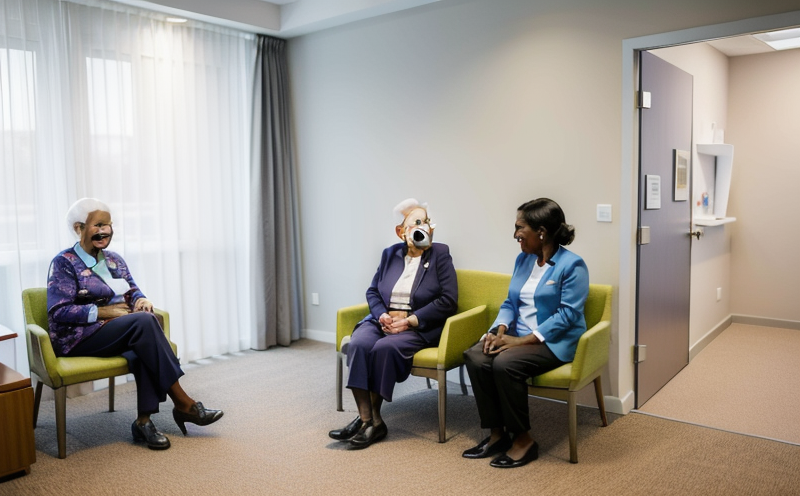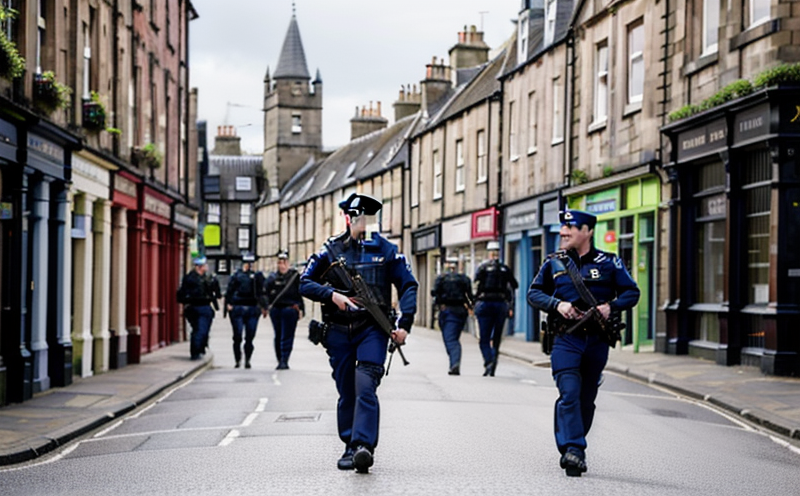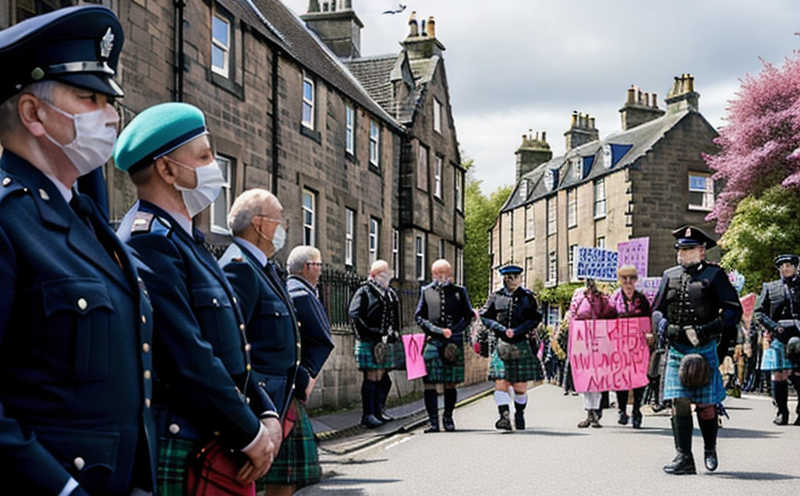Perthshire and Stirlingshire Experience Further Earth Tremors: Unpacking the Local Seismic Activity

Residents across Perthshire and Stirlingshire recently experienced a notable series of seismic events, with multiple earth tremors registered throughout the region. This activity included two distinct earthquakes, both exceeding three in magnitude, occurring on Monday at approximately 7 am and again just after 5 pm. These tremors were specifically logged near Pubil, in the vicinity of Loch Lyon, causing widespread discussion and curiosity among the local populace. The occurrence of earthquakes, while generally mild, is not an entirely unfamiliar phenomenon in this part of Scotland. Indeed, the town of Comrie holds a unique place in seismic monitoring, being home to the historic Earthquake House. Established in 1874, this specialised structure was built to house a seismoscope – an instrument designed to detect and record ground movements – and has been diligently tracking earth activity for well over a century, providing invaluable data on local and global tremors. Understanding Seismic Activity in the UK Earthquakes originate from the abrupt release of accumulated energy along fracture zones, known as faults, deep within the Earth’s crust. This sudden movement generates vibrational waves that propagate outwards, resulting in the ground shaking that people experience. The British Geological Survey (BGS), which acts as the national authority for earthquake monitoring in the UK, reports that approximately 200 to 300 seismic events are detected across the country each year. While the United Kingdom is situated far from major tectonic plate boundaries, such as the prominent Mid-Atlantic Ridge, internal stresses within these massive crustal plates can build over time. When these stresses reach a critical point, they are relieved through movement along pre-existing weaknesses or faults in the bedrock, leading to the earthquakes we observe, even far from the edges of plates. Why Perthshire and Stirlingshire are Seismically Active In Perthshire and Stirlingshire, the BGS attributes these tremors to minor shifts occurring along ancient geological faults embedded within the Earth’s crust. Given that these localised movements are typically small and occur several kilometres beneath the surface, pinpointing their exact origin and correlating them with specific faults visible on surface geological maps presents a considerable challenge for geologists. Historical records from the Perth and Kinross Heritage Trust offer insight into potential causes, suggesting a possible link to the Highland Boundary Fault (HBF). This ancient geological feature was highly active almost 400 million years ago. Historically, experts had speculated that the HBF was directly responsible for seismic activity in areas like Comrie. However, further examination indicates that some past earthquake epicentres were located to the north of Comrie, rather than south where the known trace of the HBF is located. This raises the intriguing possibility that the region’s tremors could stem from a complex network of smaller, potentially buried faults north of Comrie, a geological puzzle that continues to be investigated by researchers. The Impact of Local Earthquakes The recent tremors on Monday were widely felt throughout Perthshire and Stirlingshire, extending their reach to communities such as Aberfeldy, Kenmore, Rannoch, and Killin. Residents described experiencing a distinct ‘swaying’ sensation, with one person likening it to the feeling of ‘an underground subway passing beneath my house.’ Alongside the two larger quakes (magnitudes 3.6 and 3.7), several smaller, less perceptible tremors were also recorded on Monday, with further minor activity continuing into Tuesday morning. To put this in perspective, the largest recorded earthquake in Scottish history was a magnitude 5.4 event in Argyll, which was felt extensively across the entire country. The energy released by the most significant of Monday’s quakes was approximately 400 times less powerful than this historic event, highlighting the relatively low intensity of the recent tremors. Local memory recalls other periods of heightened seismic activity, including September and November 2020, when 29 earthquakes were noted near Blackford, with nine of these being felt by residents in Blackford itself, as well as in nearby Gleneagles and Auchterarder. On average, the UK experiences about three earthquakes of magnitude three or greater annually, with more significant tremors of magnitude four or higher occurring less frequently, typically every two to three years. Historical Perspective on Perthshire’s Earthquakes The overall earthquake hazard in the UK remains low, and incidents causing significant structural damage are exceedingly rare. However, historical records do indicate instances of minor damage, such as dislodged chimneys and cracks in buildings, resulting from past seismic events. A magnitude 5.1 earthquake in Inverness in 1901, for example, reportedly caused ‘substantial’ minor damage, though events of this scale are considered exceptional. Comrie has a particularly rich seismic history, having experienced ‘swarms’ of earthquakes during the periods of 1788-1801 and 1839-1846. The most powerful of these was a magnitude 4.8 quake in October 1839, which was even linked to a breach of the Earl’s Burn dam near Stirling. Similar sequences of closely spaced tremors, or ‘swarms,’ have been documented in other local areas. These include Glenalmond between 1970 and 1972, Doune in 1997, multiple events near Blackford in 1997, 1998, 2000, 2001, and 2020, and Aberfoyle in 2003. Notably, a 3.2-magnitude earthquake in 1979 was widely felt and is reported to have caused damage to the Glen Devon dam in the Ochil Hills. The frequent, though mostly minor, seismic activity underscores the dynamic geological character of Perthshire and Stirlingshire.
Unexplained Death Investigation Underway in Perth City Centre

A palpable sense of solemnity has descended upon the usually vibrant heart of Perth, following the discovery of a man’s body within a residential property on Scott Street. Emergency services swiftly converged on the scene late on Sunday, October 19, 2025, initiating a comprehensive police investigation into what authorities are currently describing as an unexplained death. The alarm was raised just prior to 10pm, prompting a rapid and coordinated response from local police and other essential personnel to the central Perth address. The initial assessment of the situation immediately highlighted the necessity for a thorough and meticulous inquiry, leading officers to establish a secure cordon around the vicinity. The customary quietude of a Sunday evening was consequently replaced by the serious and unmistakable presence of official vehicles and emergency responders, underscoring the gravity of the unfolding incident. Throughout the entirety of Monday, the section of Scott Street immediately affected by the incident remained under constant police watch. Uniformed officers maintained a visible presence, while specialist forensic teams, clearly identifiable by their distinctive attire, diligently carried out their work within the secured premises. Their efforts were focused on the painstaking collection of any evidence that might prove pivotal in illuminating the circumstances surrounding the man’s tragic passing. Concurrently, plain-clothed detectives were actively engaged in door-to-door inquiries, speaking with local residents and proprietors of nearby businesses, diligently piecing together a comprehensive timeline leading up to the distressing discovery. For those who reside in or frequent this well-traversed area of Perth, the sustained police activity inevitably sparked both curiosity and a profound sense of quiet concern. Scott Street, known for its mix of residential dwellings and local commercial establishments, is typically a bustling artery within the city. The sudden, unexpected, and as yet unexplained nature of a death in such a prominent location has understandably cast a shadow across the immediate neighbourhood and indeed, the wider Perth community. A spokesperson for Police Scotland issued a statement confirming the details of the incident. They reiterated that the death is being treated as unexplained, signifying that while there is no immediate indication of a cause, all possibilities remain open and are being rigorously investigated. The spokesperson further confirmed that the man’s family has been formally notified of the heartbreaking news, ensuring that those closest to him are kept informed during this exceptionally difficult period. The commitment of Police Scotland to a meticulous and exhaustive investigation is absolute. In instances where a death is classified as ‘unexplained,’ established police protocol mandates a multi-faceted approach. This typically involves, but is not limited to, detailed forensic examination of the scene, extensive interviews with potential witnesses who may hold crucial information, and a post-mortem examination to medically determine the cause of death. This stringent process is fundamental not only to potentially uncover any suspicious elements but also to provide definitive answers and closure to the grieving family and the concerned public. This somber event serves as a poignant reminder of how unforeseen tragedies can impact even the most familiar urban environments. Perth, a city renowned for its strong community spirit and rich historical tapestry, experiences such incidents with relative infrequency. The incident on Scott Street is expected to prompt discussions among residents about community safety and well-being. As the police continue their vital work, the community respectfully awaits further information, hopeful for clarity and understanding to emerge from the ongoing inquiry.
Regional Care Sector Under Spotlight: Auchterarder Carer Struck Off Amidst Broader Concerns Across Tayside, Fife, and Stirling

Care services across the wider Tayside, Fife, and Stirling regions are facing continued scrutiny, with recent reports from regulatory bodies highlighting both severe misconduct and areas requiring significant improvement. These developments underscore the critical importance of robust oversight for residents throughout Perth and Kinross, as the standards upheld in neighbouring communities often reflect broader regional trends and the collective commitment to compassionate and effective care. At the forefront of these revelations is a stark decision concerning an Auchterarder care professional. Craig Littlejohn, who worked with children and young people, has been permanently removed from the Scottish Social Services Council (SSSC) register. This severe sanction followed his conviction for stealing a substantial sum of £8,000 from an individual entrusted to his care. The SSSC unequivocally condemned his actions, characterising them as a profound breach of ethical guidelines and professional integrity. The council’s decision noted that his behaviour demonstrated blatant dishonesty, a flagrant disregard for the fundamental rights and well-being of others, and raised grave concerns about his personal character and values. His removal from the professional register became effective on October 16, sending a clear message about accountability within the care sector. Further afield, a social worker operating in Glenrothes also faced a formal warning from the SSSC due to an incident that occurred in 2024. Stephen McKenna was found to have behaved inappropriately towards a vulnerable service user who had become distressed and vocal due to a lack of support. During this challenging interaction, Mr. McKenna reportedly leaned over the woman, pointing at her face and admonishing her with aggressive language, including phrases such as, “It’s your f***ing fault, go back to your flat,” and, “The way you treated (redacted) yesterday was f***ing disgusting.” He is also understood to have issued threats concerning the potential loss of her accommodation and responded with offensive gestures after the service user had made similar signs. The SSSC deemed his conduct to display a complete lack of empathy and understanding regarding the complex challenges faced by vulnerable individuals, imposing a three-year warning on his record, which mandates disclosure to any current or future employers. Inspections Reveal Critical Lapses in Care Standards Meanwhile, the Care Inspectorate, Scotland’s independent watchdog for health and social care, has released updated assessments for several facilities. Moyness Nursing Home in Broughty Ferry was urged to significantly enhance its approach to managing patient needs and concerns. An unannounced inspection revealed that residents who primarily remained in their rooms experienced insufficient social engagement. Furthermore, inspectors observed that patient requests, even those raised in regular meetings, often took several months to be addressed. Deficiencies in care planning were also identified, including a lack of detailed personal information in records, incorrect documentation of injuries, and the absence of proper weight monitoring. Concerns were also raised regarding the cleanliness of specific care equipment. A spokesperson for the home’s operator, BCG, expressed disappointment with the new gradings but affirmed that an immediate action plan was in place, developed in collaboration with the Care Inspectorate and the Dundee Health and Social Care Partnership, with a commitment to restoring high standards. In Montrose, The Wee Childcare Company Ltd – Borrowfield Out-of-School Care Club (OOSC), which operates within Borrowfield Primary School, received a concerning report. The Care Inspectorate concluded that the safety and well-being of children attending the service were “not considered” adequately. Personal care plans were found to be implemented inconsistently, with significant variations in the level of detail regarding children’s health and additional support needs. Moreover, staff members reportedly lacked clarity on the correct procedures for administering specific medications. Despite positive relationships between staff and families, the consultation and feedback mechanisms were deemed “weak,” with a noted absence of recent efforts to gather parental opinions and limited opportunities for meaningful engagement. The Real Life Options Angus Outreach service in Arbroath also fell short in its personal care plan documentation. Inspectors found that these crucial documents lacked sufficient detail, hindering the consistent and safe delivery of care. Many plans were incomplete, undated, and contained informational gaps. It was noted that staff often provided support without immediate access to these essential personal plans. One service user candidly shared, “I have never seen my care plan and I’m not sure if there even is one,” a sentiment echoed by a family member who stated, “I’ve never seen one for a long time.” While the inspection acknowledged ongoing efforts to improve discussions and reviews of individual care, and commendations from service users regarding staff treatment, the fundamental issues with record-keeping remain a priority for improvement. Ongoing Vigilance Across the Region These detailed accounts from Broughty Ferry, Montrose, and Arbroath, alongside the SSSC decisions involving professionals in Auchterarder and Glenrothes, collectively paint a picture of an active regulatory environment. The Care Inspectorate and SSSC continue to publish numerous reports, covering a wide array of services including residential care, home support, and childcare, reflecting an unwavering commitment to upholding standards. Residents in Perth and Kinross can take some reassurance in the ongoing diligence of these regulatory bodies, which tirelessly work to ensure that all care providers in the region meet the necessary benchmarks for quality, safety, and respect for service users.
Dual Earthquakes Jolt Perthshire and Stirlingshire Within Hours, Sparking Local Discussion

Communities spanning the heart of Scotland, particularly across Perthshire and Stirlingshire, experienced an extraordinary day on Monday as two distinct seismic events, occurring within a mere 12-hour window, caused widespread rumbling. The more pronounced of these tremors, registering a magnitude of 3.7, sent noticeable vibrations through homes and businesses late in the afternoon, prompting widespread surprise and discussion among residents. The epicentre of this afternoon’s stronger quake was precisely located at Pubil, an area situated near the stunning Loch Lyon, deep within the rugged landscape that defines parts of Perthshire. The ripple effect was extensive, with local councils confirming that the vibrations were distinctly felt across a broad swathe of the region. From the historic city of Perth itself to the scenic towns of Kinross and Cupar in Fife, the ground’s unexpected movement became an immediate talking point. Further afield, cities like Edinburgh and Glasgow, and even the distant coastal town of Stonehaven, received reports of the tremor, highlighting its considerable reach. First-hand accounts from those who felt the earth shift underscored the unusual nature of the event. Many described an unsettling sensation of “some swaying” within their properties, an experience that caused momentary alarm. One resident vividly articulated their surprise, comparing the feeling to “an underground subway” passing directly beneath their home. These personal narratives collectively paint a picture of an unexpected and memorable incident, particularly in a country where such powerful tremors are far from a daily occurrence. A Preceding Jolt in the Morning The Monday afternoon event wasn’t an isolated incident; it was preceded by an earlier, though slightly less potent, earthquake. This initial tremor, measuring 3.3 in magnitude, had already stirred residents awake at 7:25 AM. Its origin was also located in the Perthshire and Stirlingshire borderlands, reaching communities including Aberfeldy, known for its whisky and distilleries, Pitlochry, a popular tourist destination, and the tranquil villages of Kenmore, Rannoch, and Killin. For many, the early morning shake-up was an abrupt and startling start to the week. The clustering of seismic activity on a single day, particularly in the same geographical vicinity, naturally piqued the interest of geological experts. The British Geological Survey (BGS), the principal governmental body for seismic monitoring in the United Kingdom, confirmed that the Pubil area near Loch Lyon exhibited continuous seismic unrest throughout Monday. In addition to the two headline events, the BGS logged a series of smaller, yet perceptible, tremors. These included a 2.7-magnitude earthquake recorded at 4:29 PM, shortly before the stronger 3.7 event, as well as six other minor quakes ranging from 0.8 to 1.4 in magnitude. This continuous, albeit low-level, activity points to an active geological process unfolding beneath the surface. Reflecting on Local Experiences and Geological Context For the inhabitants of Perth and Kinross, and indeed wider Central Scotland, encountering multiple earthquakes in such rapid succession is a truly rare phenomenon. While the magnitudes of these tremors were not high enough to pose a significant risk of widespread structural damage, the collective experience of the ground moving beneath one’s feet can certainly be unsettling. Social media platforms and local community groups quickly became hubs for shared experiences, with people from various towns and villages confirming they had felt the same surprising jolt. From the bustling streets of Perth, where morning commuters might have initially dismissed the rumble as heavy traffic, to the serene, rural settings near Aberfeldy and Pitlochry, the tremors served as a stark reminder of the planet’s underlying geological dynamism. Scotland, often perceived as geologically ancient and stable, does experience minor seismic events due to ancient fault lines that crisscross the landscape and ongoing post-glacial rebound, a process where the land slowly rises after being compressed by ice sheets millennia ago. The cluster of activity around Pubil and Loch Lyon, an area known for its dramatic landscapes, might be attributed to local stress adjustments along these ancient geological features. While the recent events primarily caused surprise rather than alarm, it’s a pertinent moment for residents to briefly reflect on basic earthquake safety, such as the “Drop, Cover, and Hold” protocol, even if large-scale destructive quakes remain highly improbable in the UK. The British Geological Survey continues its diligent monitoring, ensuring that any further seismic activity in Perthshire, Stirlingshire, or elsewhere in the UK is promptly recorded and analysed, offering reassurance and insight to local communities whose Monday was certainly out of the ordinary.
Man Jailed After Attempted Murder Involving Car Theft and Perilous Ride on Dunkeld Bridge

A harrowing incident unfolded in the picturesque Perthshire town of Dunkeld, culminating in a Glasgow High Court sentencing for attempted murder. Lewis Brydon, 23, from an undisclosed location, received a substantial prison term following a shockingly reckless crime that saw a car owner desperately clinging to the roof of his own vehicle as it sped through the town. The sequence of events began innocently enough at a local bicycle shop in Dunkeld, where the victim, 40-year-old Adam Flint, was briefly distracted. While a companion engaged Mr. Flint with inquiries about bike rentals, Brydon seized an opportune moment. He quickly snatched the keys to Mr. Flint’s high-performance Audi S4, which had been left within reach near the shop counter, and made a swift exit. Realizing the theft, a determined Mr. Flint immediately mounted an e-bike and launched a pursuit. As he cycled furiously down the street, he alerted passers-by to the unfolding crime, shouting that his car was being stolen. His chase brought him face-to-face with Brydon when the stolen Audi stalled. Mr. Flint courageously positioned himself in front of the car, demanding that the thief exit the vehicle. However, Brydon’s response was not to yield. Instead, he revved the engine and deliberately nudged the Audi forward, forcing Mr. Flint off his e-bike and onto the car’s bonnet, where he made contact with the windscreen. Without hesitation, Brydon accelerated, driving directly over the fallen e-bike and continuing his escape. In a desperate bid to prevent his stolen property from vanishing, Mr. Flint found himself clinging precariously to the roof of his own car as it gathered speed. Witnesses described a terrifying scene, reporting Brydon driving the Audi erratically at speeds of approximately 50 miles per hour. It was evident to onlookers that Brydon’s dangerous manoeuvres, including accelerating and decelerating, were calculated attempts to dislodge Mr. Flint from his precarious position. The ordeal continued for a significant distance, with Brydon driving for a third of a mile, including a perilous journey across the historic Dunkeld Bridge – a structure notable for its 50-foot drop to the River Tay below. The sheer audacity and inherent danger of Brydon’s actions shocked the community. The terrifying ride came to an abrupt halt when Brydon clipped a kerb at high speed, veering onto a grass verge before finally crashing into a tree. The impact violently threw Mr. Flint from the Audi, sending him tumbling into nearby bushes. Miraculously, despite the extreme danger and the force of the crash, Mr. Flint sustained only superficial scratches and abrasions. Brydon, on the other hand, fled the scene on foot, as Mr. Flint, bruised but remarkably resilient, shouted for others to try and apprehend the escaping thief. Authorities were swiftly involved, and Brydon was later identified as the culprit. When contacted by a police officer on his mobile phone, he refused to disclose his whereabouts but notably inquired about Mr. Flint’s condition, asking: “Is the guy from the car alright?” He eventually surrendered to the police, attributing his actions to being “under the influence” at the time of the incident. Further investigation revealed that Brydon possessed no valid driving licence, and was, alarmingly, already subject to four separate bail orders for previous allegations of violence, theft, and housebreaking, highlighting a troubling pattern of criminal behaviour. At the Glasgow High Court on October 20, 2025, Lewis Brydon formally admitted to the charge of attempted murder. During the proceedings, his defence counsel, Duncan McPhie, conveyed Brydon’s “profound sorrow” for the offence, describing it as “opportunistic and reckless.” However, Lord Colbeck underscored the gravity of Brydon’s actions. Handing down a sentence of six years and nine months, the judge remarked on the potential for far more severe consequences given the circumstances. He also emphasized the lasting psychological impact Brydon’s actions had inflicted upon Mr. Flint, acknowledging that while physical injuries were minimal, the emotional and mental scars would endure. This case serves as a stark reminder of the potential for routine criminal acts to escalate into extraordinarily dangerous situations, leaving a lasting impression on the Perthshire community.
Essential Travel Update: Navigating Disruptions Across Perthshire, Fife, Dundee, and Stirling

Residents and commuters across Perth and Kinross are advised to plan their journeys carefully over the coming weeks, as a series of significant travel disruptions are set to affect major road networks and public transport services in the region, extending into Fife, Dundee, and Stirling. This comprehensive overview details upcoming road closures, diversions, and changes to bus and train schedules, with some projects continuing into early 2026. A notable advisory for Perthshire concerns a substantial 70-mile diversion that will impact travel near Aberfeldy. This intricate network of changes highlights the importance for local communities to stay informed and adjust their travel plans accordingly to minimize inconvenience. Crucial Road Updates for Perth and Kinross For those travelling within Perthshire, several key arteries will see planned works. The *A827 at Bolfracks, near Aberfeldy*, will be closed between Aberfeldy and Kenmore from Mondays to Fridays, running from October 13 to October 26, 2025. This closure is critical for retaining wall repairs, necessitating the implementation of a lengthy 70-mile diversion route. Drivers should factor in significant additional travel time for journeys through this picturesque but currently constrained part of Highland Perthshire. Further along the A827, at *Grandtully*, closures and parking restrictions are scheduled from October 27 to November 7, 2025. Meanwhile, the *A926 High Street in Rattray* faces an emergency road closure from the A93 Balmoral Road to Hatton Road, which began on September 9, 2025, and is expected to continue until October 27, 2025. Vital wall repairs will also be undertaken on the *A85 at Gilmerton*, specifically at Fasgadh House on Perth Road, from October 20 to October 24, 2025. Temporary traffic lights will manage traffic flow between 8am and 4:30pm during these days. The extensive road safety improvements on the *A90 between Perth and Dundee* are nearing completion, with works continuing until October 31, 2025. This project, stretching from Rait junction to Middlebank Farm, involves a lane two closure, a 30mph speed limit, and an overnight convoy system in lane one from 9pm to 5am, with weekends seeing a lifting of these restrictions. Additionally, overnight resurfacing operations are ongoing on the *A9 at Luncarty* from October 14 to October 28, 2025, under temporary traffic lights and a convoy system from 7pm to 6am, with no weekend works. More localized closures include the *B8033 at Braco* (closed with parking restrictions from October 20 to October 31, 2025), the *B948 at Coupar Angus* (Athole Street, Causewayend, and George Square closed from October 22 to October 31, 2025), and *Station Road in Invergowrie* (closed with parking restrictions from October 20 to October 31, 2025). Dundee, Angus, Fife, and Stirling Road Networks For those commuting into Dundee, *Reform Street* in the city centre will be closed from Bank Street to Meadowside between October 15 and October 29, 2025, to facilitate Scottish Water sewer repairs. Other Dundee closures include *Craigie Avenue* (from Greendykes Road to Arbroath Road until October 26, 2025, for gas works), *Kings Cross Road* (at its junction with Harefield Road for two days of patching and lining on October 22-23, 2025), *Law Road* (closed from the turning area to Law summit for nine weeks of conservation from October 13 to December 12, 2025), and *Pirkerro Road* (closed northbound from Clepington Road to the Kingsway for Scottish Water works from October 20 to October 23, 2025). The *A90 Kingsway in Dundee* will also experience an overnight convoy system between the A923 Coupar Angus off-slip and Strathmartine Road (October 5-27, 2025), alongside northbound slip road closures. Further, overnight lane closures for resurfacing works will affect Strathmartine Road from October 26 to November 9, 2025. The *A90 Forfar Road* will see a northbound lane closure for landscape works (October 20-22, 2025) and a southbound lane closure for barrier repairs (October 23-24, 2025). In Angus, the *A90 at Brechin* will have overnight lane restrictions (northbound and southbound) from October 27 to November 7, 2025, followed by a contraflow system extending until December 2025. Additional Angus roadworks include *B9127 Arbirlot Road West, Arbroath* (closed October 23, 2025, for Scottish Water works), *B9128 North Street, Forfar* (closed at Market Street from September 22 to October 24, 2025, for dropped kerb works), and *Liff Road* (closed between the A923 at Muirhead and Woodside Road for carriageway works from October 20 to October 27, 2025). Fife residents will contend with the *A921 Aberdour Road, Burntisland*, which is closed from Cromwell Road to Kirkton Road for resurfacing from October 20 to October 24, 2025. A long-term closure affects the *B917 Black Road, Kelty*, from 46 Black Road to the B996 Great North Road, for sewer works from September 29, 2025, to February 27, 2026. Other closures include *Glenlyon Road, Leven* (October 26-27, 2025, for Scottish Water works) and *Glenwood Road, Leslie* (closed between Golf Course Road and Sapphire Paper Mill for duct installation works from September 22, 2025, with no end date specified). In Stirling, the *A82 at Glen Falloch, Inverarnan*, will experience a lane closure, temporary traffic lights, and a 30mph speed limit at the Dubh Eas Bridge from October 6 to October 21, 2025. The *B834 near Killearn* is closed at Blanewater Bridge between 9am and 4pm for maintenance from October 27 to October 29, 2025. Furthermore, *Forthside Way, Stirling*, remains closed from Shore Road to the roundabout at Forthside car park between 8am and 5pm, from September 22 to December 5, 2025, for active travel route construction. Public Transport Alterations Bus commuters should note diversions for *Stagecoach services 73, 73A, 73B, and 73C* in Dundee, which will redirect northbound along Craigie Avenue onto Greendykes Road and Arbroath Road until November 1, 2025, affecting certain stops. *Stagecoach 21A* in Angus is diverting along the A90 due to low-hanging trees from Storm Amy, with no end date yet confirmed. *Xplore Dundee service 5A*, heading only for Ninewells Hospital, will divert between Greendykes Circle and Eastern Cemetery until October 26, 2025, with alternative stops available near Balgavies Avenue and Dalgleish Road. In Fife, *Stagecoach BE3, 33A, and X56 services* in Kelty will
Police Operations Underway Following Disappearance of Aberfeldy Man in Perth City Centre

A concentrated effort is presently underway to locate a 37-year-old man from Aberfeldy, Henry Martin, who was last observed in the heart of Perth on a recent Saturday afternoon. Concerns for Mr. Martin’s welfare have prompted authorities to initiate a comprehensive search across the area. Mr. Martin was reportedly seen in Perth city centre, moving in the direction of South Street, a prominent and busy thoroughfare known for its mix of shops, restaurants, and historical buildings. The last sighting occurred at approximately 12:30 PM on Saturday, creating a timeline for investigators to follow in their search. Described as being approximately six feet tall with a lean physique, Mr. Martin has short brown hair and brown facial hair. At the time of his disappearance, he was dressed in a Barbour-style jacket, navy chinos, white socks, and grey Adidas trainers. This detailed description is crucial for anyone who may have encountered him in the busy urban environment of Perth or its surrounding areas. Community Engagement and Investigative Progress The local community in both Aberfeldy and Perth has expressed significant concern following the news of Mr. Martin’s vanishing. Aberfeldy, a picturesque town nestled in the heart of Perthshire, is known for its close-knit community, and news of a missing resident quickly resonates throughout the area. Perth, as a regional hub, sees a constant flow of people, making the task of tracing movements through its city centre particularly challenging but not insurmountable for experienced police teams. South Street itself is a vital artery of Perth, connecting various parts of the city and leading towards key exits and residential areas. Understanding the specific direction Mr. Martin was heading provides a focal point for initial inquiries, allowing officers to review available CCTV footage and interview individuals who may have been in the vicinity at the critical time. Widespread Search Initiatives Authorities have confirmed that extensive inquiries are ongoing to ensure Mr. Martin’s safety. These operations typically involve a multi-faceted approach, ranging from ground searches in areas he might have frequented to leveraging technology and local networks. The welfare of individuals in such circumstances is always the paramount concern for those involved in search efforts. The collaborative nature of these investigations often includes local police divisions working closely with specialised search teams, drawing on their expertise and resources. Whether extending searches to local green spaces and riverbanks common in Perth and Kinross, or widening the scope to include transport links, all avenues are explored to achieve a positive outcome. The local landscape, from the urban sprawl of Perth to the more rural, serene settings near Aberfeldy, presents diverse environments that search teams must consider. The River Tay, a dominant natural feature in Perth, is also routinely factored into any missing person inquiries in the area, given its proximity to the city centre. However, the immediate focus remains on Mr. Martin’s last known movements and the detailed description of his appearance. These situations highlight the strength and solidarity within the Perth and Kinross community, where residents often play a vital role by remaining vigilant and reporting anything unusual that might assist police in their duties. The collective hope is for Mr. Martin to be found safe and well, allowing him to return to his home in Aberfeldy and his family. The ongoing police work reflects the commitment to resolving such concerning situations with utmost diligence.
Body Recovered in Search for Missing Perth Woman Lucy Sheldon

A somber development has emerged in the search for 46-year-old Lucy Sheldon, who was reported missing from Perth. Police Scotland has confirmed that a body has been discovered in water near Stormontfield, an area well-known for its scenic beauty and proximity to the majestic River Tay. The intensive search operation for Ms. Sheldon began on Saturday after she was reported missing. Concerns grew when her vehicle was found parked at the hydro station, a familiar landmark close to the village of Luncarty. She was last observed walking on a path in the vicinity of the hydro station at approximately 1:20 pm on that day. Community Impact and Search Efforts The news of Ms. Sheldon’s disappearance had sent a wave of concern through the tight-knit communities of Perth and Kinross, particularly in and around Stormontfield and Luncarty. These areas, characterised by their tranquil landscapes and the meandering flow of the River Tay, are popular spots for local walkers, anglers, and nature enthusiasts. The presence of emergency services in such a peaceful setting naturally drew attention and prompted many local residents to hope for a safe return. Specialist search teams, including Police Scotland officers, would have been deployed to meticulously scour the riverbanks and surrounding natural terrain. The River Tay, Scotland’s longest river, presents a formidable and challenging environment for search operations, with its fast-flowing currents and varied depths. The hydro station, a key reference point in the search, is nestled within a landscape that, while picturesque, can be unforgiving and difficult to navigate, especially for those unfamiliar with its hidden dangers. Local volunteers and community groups, often the backbone of support during such distressing times, would likely have offered assistance, demonstrating the strong community spirit prevalent in Perthshire. The collective hope of finding Ms. Sheldon alive would have driven these efforts, reflecting the compassionate nature of the region’s inhabitants. Official Confirmation and Next Steps Following the discovery, Police Scotland issued an official statement regarding the recovery of a body. While formal identification procedures are still underway, the family of Lucy Sheldon, who had been anxiously awaiting news, has been notified of this significant development. This sensitive process ensures that families are informed with the utmost care and respect during difficult circumstances. The full police statement confirmed: “A body has been found in water near Stormontfield. Formal identification has yet to take place but the family of Lucy Sheldon, 46, from Perth, have been informed. A report will be sent to the procurator fiscal.” The procurator fiscal, an independent public prosecutor in Scotland, will receive a report detailing the circumstances surrounding the death. This is a standard procedure in Scotland when a death is sudden, unexplained, or suspicious, or occurs in circumstances that require further inquiry. It ensures that all necessary legal processes are followed and that appropriate investigations are conducted, providing clarity and closure for all involved. The community will undoubtedly continue to extend its thoughts and support to Lucy Sheldon’s family and friends during this profoundly difficult period. The incident serves as a poignant reminder of the importance of community vigilance and support networks in times of crisis within Perth and Kinross.
Urgent Search Underway for Missing Perth Woman After Car Discovered Near River Tay

A comprehensive search operation is currently in progress across the Perthshire landscape following the disappearance of 46-year-old Lucy Sheldon from Perth. Concerns are mounting for Ms. Sheldon’s welfare after her car was found unattended in a location adjacent to the majestic River Tay, prompting an immediate response from emergency services and dedicated local teams. The alarm was raised when Ms. Sheldon’s distinct Fiat 500, bearing the registration ST24 JNV, was located at the Stormontfield Hydro Station. This peaceful, yet somewhat secluded area, nestled close to the village of Luncarty, is renowned among local residents for its scenic walking paths that trace the meandering curves of the River Tay. Ms. Sheldon was last observed on Saturday at approximately 1:20 PM, walking along one of these very paths, heading northwards from the hydro station. Her unexpected absence from such a familiar and often frequented route has intensified worries among those who know her and the wider community. Authorities have provided a description of Lucy Sheldon to assist the public in their vigilance. She is described as being approximately 5ft 4in tall, possessing a slim build, and is distinguished by her long, brown hair. At the time of her last sighting, she was dressed in a black puffer jacket, black leggings, and black and white shoes. These details are crucial for anyone who may have been in the vicinity on Saturday afternoon or has information pertinent to her whereabouts. Inspector Cook, leading the ongoing police efforts, has underscored the serious nature of Ms. Sheldon’s disappearance, stating it is highly uncharacteristic for her to lose contact with her family and friends. The passage of time since she was last seen only serves to deepen the anxiety surrounding her safety. Police Scotland officers have swiftly initiated extensive inquiries across the area, coordinating a meticulous search strategy that includes detailed examinations of the riverbanks and surrounding terrain near Stormontfield and Luncarty. The River Tay, while a beautiful natural asset to Perth and Kinross, presents unique challenges in search and rescue operations. Its powerful currents and often dense riparian vegetation can complicate efforts, requiring specialized techniques and persistent dedication from search teams. The local community, familiar with the river’s dual nature of beauty and potential peril, shares in the collective hope for Ms. Sheldon’s safe return. Such incidents often galvanize residents, highlighting the tight-knit spirit of Perthshire towns and villages where the welfare of every individual is deeply felt. Police have meticulously examined the area where Ms. Sheldon’s car was found, including any potential access points to the river or less-frequented tracks. The discovery of her vehicle has placed a critical focus on the immediate surroundings of Stormontfield Hydro Station, a spot that, while popular, can quickly become isolated depending on the specific path taken. The search effort is comprehensive, designed to leave no stone unturned in the pursuit of locating Ms. Sheldon. The profound concern of her family and friends resonates deeply within Perth and Kinross, a region where community bonds are strong. Residents often rely on these serene natural spaces for recreation and tranquility, and the news of a missing person in such a beloved area invariably prompts a collective feeling of unease and a desire to help. The local community remains hopeful and vigilant, demonstrating the inherent support network present in this part of Scotland. In their ongoing efforts, police have appealed for public assistance. They are urging anyone who was in the Stormontfield Hydro Station or Luncarty areas on Saturday afternoon, and who may have seen Lucy Sheldon or her distinctive Fiat 500 (registration ST24 JNV), to come forward. Additionally, anyone with dash cam footage captured in the vicinity during that time is encouraged to review it, as even the smallest detail could prove vital. Police have requested that individuals with any information that could aid the search contact 101, quoting the reference number 1826 of October 18.
Perth Navigates Complex Immigration Debate as Anti-Immigration Protest Draws Large Turnout

Perth city centre recently witnessed its latest large-scale demonstration concerning immigration, drawing over 100 participants to express their views. The event, spearheaded by a group identified as ‘Pink Ladies’ and supported by ‘Perth’s Peaceful Protest,’ marked a significant moment in the ongoing local discourse surrounding asylum seekers residing in the city’s hotels. This particular march, held on a Saturday, was the sixth such gathering to take place in Perth since August, highlighting persistent community interest and concern. It notably represented the inaugural public procession led under the ‘Pink Ladies’ banner, a name also associated with similar demonstrations at hotels in other parts of the UK. However, direct organisational links between the Perth group and these external entities remain unspecified. In anticipation of the demonstration, Perth and Kinross Council had previously communicated that no official public procession licence had been sought by the organisers. This advisory aimed to inform the public about the event’s regulatory status within the local area, underscoring adherence to established guidelines for public assemblies. The backdrop to these protests involves approximately 190 asylum seekers currently accommodated in two hotels within Perth. Despite repeated assurances from Perth and Kinross Council that there are no immediate plans to significantly increase these numbers – specifically refuting claims of an additional 250 individuals – the issue continues to fuel discussions and public gatherings. Earlier insights from a local publication revealed the personal experiences of three asylum seekers living in Perth, who shared their earnest desire to integrate and contribute positively to the city, even amidst the prevailing atmosphere of hostility. Their testimonies offered a poignant contrast to the public sentiment expressed by some protesters, illustrating the human dimension of the debate. Events Unfold in Perth City Centre On the day of the march, the North Inch served as the starting point for the assembly, which included women adorned in pink attire, some accompanied by children, alongside larger contingents of men displaying Saltires and Union flags. Prior to their departure, law enforcement officials, through a megaphone, issued a clear warning to the assembled groups regarding the potential for arrest should they proceed with an unlicensed procession. This official admonition was met with vocal dissent from some attendees, who responded with exclamations of displeasure. However, a local business figure, Lee Stronach, known for his involvement in previous organisational efforts for such protests, intervened to de-escalate the situation, urging participants to remain calm. Mr. Stronach then guided the procession through several prominent arteries of the city, including Tay Street, High Street, South Street, and Leonard Street, drawing attention across various public spaces. Voices from the March and Public Reaction A 25-year-old female participant, who chose to remain anonymous, articulated her motivation for joining the march. She emphasized that the protest was driven by concerns for ‘the safety of women, kids and possibly men,’ unequivocally rejecting any association with far-right or racist ideologies. She highlighted a perceived shortage of resources for existing local populations, questioning the rationale behind accommodating more ‘undocumented people’ when local services are already stretched. Her statement reflected a sentiment that Perth, in her view, is undergoing undesirable changes, leading to anxieties about the safety of girls within the community. ‘I’m mixed race, and my family is like the United Nations. It’s not about skin colour,’ she stated, reinforcing her position. Throughout the march, protesters engaged in chants critical of both law enforcement and the local authority, and were observed shouting phrases like ‘Send them home.’ They also directed audible disapproval towards journalists covering the event. Public response along the route was varied; some motorists expressed solidarity by honking their horns, while other members of the public openly conveyed their disagreement, leading to at least one minor physical altercation. Despite the visible tensions, Police Scotland later confirmed that no arrests were made in connection with the demonstration, indicating their assessment that the procession largely adhered to legal boundaries by remaining on pavements. Council Leader’s Stance and Call for Dialogue Simultaneously, a counter-demonstration organised by ‘Perth Against Racism’ convened outside the Radisson Blu Hotel, one of the accommodations housing asylum seekers. Notably, the newly appointed leader of Perth and Kinross Council, Eric Drysdale, joined the ranks of the counter-protesters, signifying the local authority’s stance on the matter. Speaking to the press, Mr. Drysdale acknowledged the constitutional right to protest but underscored his belief that any such actions should be directed towards critiquing the systemic issues that lead to prolonged stays for asylum seekers, rather than targeting the individuals themselves. He conveyed that law enforcement had informed him that the marchers did not breach legal parameters as long as they confined themselves to pedestrian areas. Mr. Drysdale stressed the imperative for the UK Government to urgently devise effective solutions to what he termed the ‘logjam’ in the asylum system, hoping that such measures would contribute to the de-escalation of public tensions in Perth. While expressing concern over the current situation, he reiterated the council’s limited capacity to intervene as long as protests remain within legal bounds. Despite the complexities, Council Leader Drysdale extended an offer for private dialogue, stating, ‘If a representative of the protesters wishes to meet with me privately, I don’t have an issue with that.’ This gesture aimed to open lines of communication amidst a deeply polarised local debate, seeking a path towards understanding and resolution within the community.

